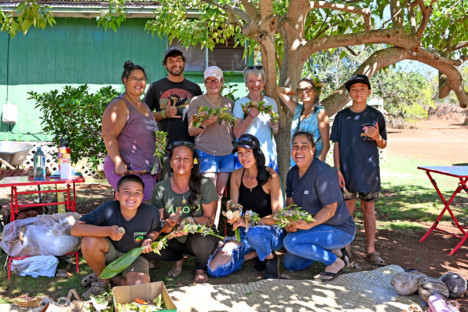Lei Making with Maiʻa Bark

Molokai Arts Center’s Hawaiian Arts program offered a lei-making workshop utilizing the bark of the mai‘a tree, or banana tree, taught by Kaulananapua Dudoit Oct. 11 and 25. Photos by Léo Azambuja
By Léo Azambuja
Early Polynesian seafarers brought at least 23 different plant species to Hawaii, and among them the maiʻa, or banana. The Hawaiian Arts program at Molokai Arts Center singled out the maiʻa for a free two-part lei-making workshop that concluded last weekend in Hoʻolehua.
“Today, we are going to learn how to make roses first, and then we are going to try and build the lei,” Kaulananapua Dudoit told about a dozen people at the start of the workshop, as she grabbed a piece of dried banana bark and gracefully twisted it to create a small rose in a few seconds.
Two weeks earlier, Dudoit had taught the first portion of the workshop at the Hoʻolehua Homestead Makeke, when she taught how to do roses using dried bark of banana trees. Last Saturday morning, after a quick recap, everyone got to make roses that would be weaved into a lei poʻo, which is a lei worn on the head.
“I use ti leaf for the backing, and then I use the maiʻa bark again for the raffia to wrap it,” she said, adding she likes to use readily available materials in her homestead land. “I pick what I have. Usually, I use the maiʻa for the backing, but today I only had a few in my yard, so I just picked ti leaf because I had a lot of ti leaf.”
With ti leaves used as the base, workshop attendants used the maiʻa raffia to tie the maiʻa roses together with kukui leaves, ferns and ʻaʻaliʻi and crown flowers to create their lei poʻo.
“You add the roses, you add things in there, it gets more beautiful,” Dudoit said.
Crown flowers — five pointed petals with a small crown rising from the center — are not native to Hawaii, but Dudoit said these little purple flowers used to be Queen Liliuʻokalani’s favorite flowers. Whenever there are events honoring the queen, she said, it’s common that people make lei or arrangements with crown flower.
Dudoit highlighted the cultural significance of lei-making, noting its role in connecting people and preserving Hawaii’s living traditions.
“I make lei from a very young age,” Dudoit said. Growing up on the island’s East End, she attended Kilohana Elementary School, where she would always win student lei contests. “I would always make roses out of ti leaf, and put it in the ti leaf lei.”
One day, she wanted to make a lei but didn’t have any flowers in her yard. Rather than adding ti leaf roses, she experimented with roses made of maiʻa bark, and it was an instant hit.
In the first portion of the workshop series, Dudoit said most people were from the mainland, and some had a hard time doing a lei. But with patience and practice, anyone can do it, she said.
“You just gotta put your mind to it and take your time. And go slow; you don’t have to do it fast,” she said.
Dudoit has seen first-hand the effects that lei have on people. It just makes them happier, whether they made one for themselves or made it to give it away, she said.
“Make a lei every day. Everybody should make a lei every day,” she said.
The maiʻa lei workshop was part of MAC’s Hawaiian Arts program.
“We are grateful for the Maui County Office of Economic Development for a grant that allows us to do this program,” MAC executive director Alice Kaahanui said.
The workshops are offered as a partnership between the HĀ program, the Hoʻolehua Homesteaders Association and the Hoʻolehua Homestead Makeke.
The idea, Kaahanui said, is to bring homestead vendors, or “ʻāinapreneurs,” to the Makeke during the workshops, increasing economic viability for the vendors. The workshops are free, but donations are welcome.
Visit www.molokaiartscenter.org for information on upcoming events or to donate.











Don't have a Molokai Dispatch ID?
Sign up is easy. Sign up now
You must login to post a comment.
Lost Password